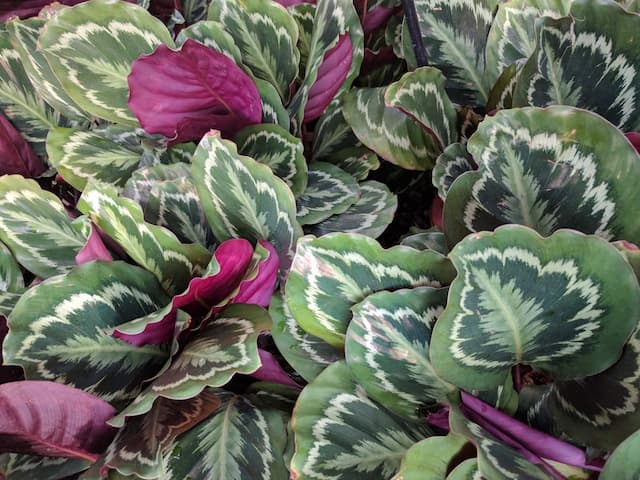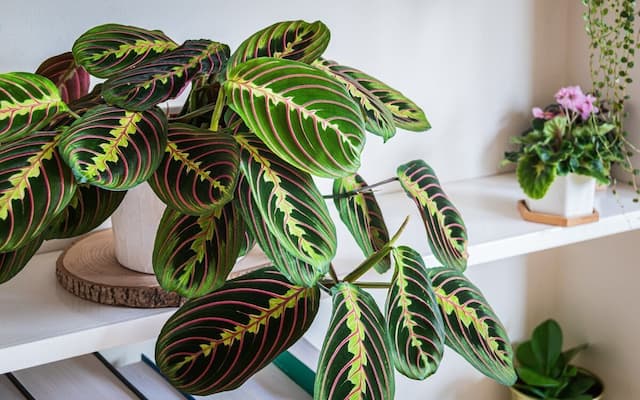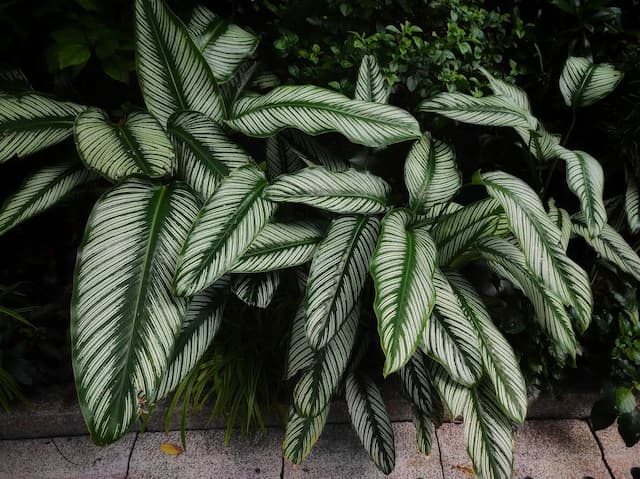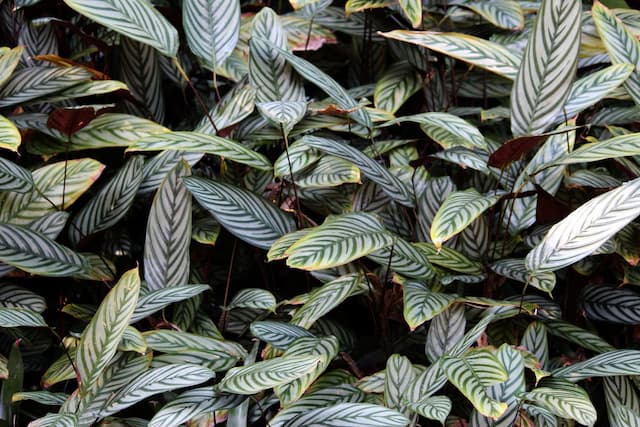Calathea Network Goeppertia kegeljanii Network = 'Pp0005' (PBR)
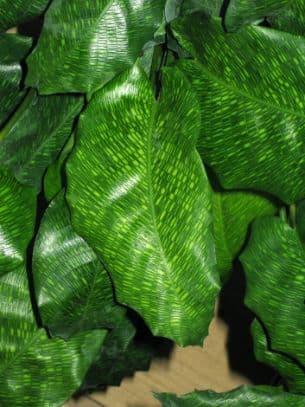
ABOUT
The Goeppertia kegeljanii Network, commonly known as the Calathea Network, exhibits a unique and ornate foliage pattern. Each leaf boasts a complex network of light and dark green, creating a mosaic-like effect. This intricate patterning almost looks hand-drawn, with the contrasting colors following the natural veining of the leaves. The leaves themselves are elongated and gently taper to a point, with a wavy margin that adds a dynamic visual texture. Their underside commonly presents a purplish hue which contrasts the vivid green on top, adding to the plant's distinctiveness. Notably, the Calathea Network is recognized for its ability to move its leaves in response to the light, a phenomenon known as nyctinasty, which further augments its lively appearance.
About this plant
 Names
NamesFamily
Marantaceae
Synonyms
Calathea Network, Network Prayer Plant
Common names
Calathea musaica, Goeppertia bella, Calathea bella, Calathea kegeljanii
 Toxicity
ToxicityTo humans
The plant Goeppertia kegeljanii, commonly known as Calathea Network, does not have a high toxicity level to humans. It is generally considered non-toxic, and ingesting parts of the plant typically does not lead to serious poisoning. However, it is still advisable to avoid consumption as it can potentially cause mild discomfort or an allergic reaction in some people. If symptoms do occur, they may include mild nausea, vomiting, or diarrhea.
To pets
The plant commonly known as Calathea Network is not considered highly toxic to pets. However, ingestion can cause mild gastrointestinal discomfort. If a pet consumes any part of the Calathea Network, they might exhibit symptoms such as vomiting or diarrhea. Although not severely toxic, it is still recommended to keep the plant out of reach to prevent any potential negative effects on your pet's health.
 Characteristics
CharacteristicsLife cycle
Perennials
Foliage type
Evergreen
Color of leaves
Variegated
Height
2 feet (60 cm)
Spread
2 feet (60 cm)
Plant type
Herb
Hardiness zones
11
Native area
Central America South America
Benefits
 General Benefits
General Benefits- Decorative appeal: The plant has a distinctive patterned foliage that adds aesthetic value to indoor spaces.
- Low maintenance: It requires minimal care, making it suitable for busy individuals or those new to keeping houseplants.
- Adaptability: It can thrive in a variety of indoor environments, from low to bright indirect light.
- Humidity tolerance: It can tolerate higher humidity levels, making it ideal for bathrooms or kitchens.
- Non-toxic to pets: The plant is safe for homes with pets, reducing concerns about accidental ingestion.
- Mood enhancement: Its presence can contribute to a calming ambience and improve overall mood in a living space.
- Longevity: With proper care, the plant can live for many years, providing enduring natural decor.
 Medical Properties
Medical PropertiesThis plant is not used for medical purposes.
 Air-purifying Qualities
Air-purifying QualitiesThis plant is not specifically known for air purifying qualities.
 Other Uses
Other Uses- Calathea 'Network' can be used as a tool for education in botany and horticulture classes, showcasing the intricacies of leaf patterning and how it can occur naturally in the plant kingdom.
- The striking patterns of the Calathea 'Network' leaves can inspire artists and designers, serving as a natural muse for patterns in textiles, wallpapers, and graphic designs.
- This plant can be used in terrariums or vivariums as part of the ecosystem to provide shelter and visual interest for small creatures like frogs or geckos.
- It can act as a natural humidifier when grouped with other plants, contributing to a microclimate that increases the humidity levels of a room.
- Calathea 'Network' can be used in photography as a stunning and exotic backdrop for product shots or portraits, adding depth and texture to the image.
- Planted in an office space, it can act as a natural divider to create private sections or nooks due to its dense foliage.
- The plant can be used in Feng Shui practices as it is believed to bring a balance of energy into a home or business due to its symmetrical leaf patterns.
- The complexity of the 'Network' leaf pattern can serve as an inspiration for educational activities with children, such as leaf drawing or patterning exercises.
- Using the Calathea 'Network' as a centerpiece in a dining or meeting table setup can add an exotic and sophisticated touch to the arrangement.
- During themed events or parties, the Calathea 'Network' can serve as a live decoration element, offering a tropical flair to the ambiance.
Interesting Facts
 Feng Shui
Feng ShuiThe Calathea Network is not used in Feng Shui practice.
 Zodiac Sign Compitability
Zodiac Sign CompitabilityThe Calathea Network is not used in astrology practice.
 Plant Symbolism
Plant Symbolism- Rarity and Uniqueness: Goeppertia kegeljanii 'Network', also known as the Calathea Network, is a relatively rare and unique variety. Its intricate pattern symbolizes the individuality and distinctiveness of each person's path in life.
- Mystery and Intrigue: The complex, almost digital-looking pattern on the leaves gives a sense of enigma, signifying complexity and layers of meaning in life.
- Balance: Calatheas are known for the balance in their symmetrical leaf patterns, which can represent the quest for equilibrium in various aspects of life.
- Well-being and Growth: The vibrant green color and the nature of the plant to grow under the canopy layer in forests signify health, growth, and prosperity.
- Connection to Nature: As a houseplant that is native to tropical areas, the Calathea Network reminds one of the connection to the natural world and the importance of respecting and living in harmony with nature.
 Water
WaterThe Calathea Network should be watered regularly with small amounts of water. Typically, watering once a week is sufficient, but this can vary depending on the humidity and temperature of your environment. It's important to keep the soil evenly moist but not waterlogged. During the growing season (spring and summer), it may require slightly more frequent watering. A methodical approach is to use about 8 to 16 ounces of water per week, depending on the size of the plant and pot.
 Light
LightThe Calathea Network prefers bright, indirect light, making it an ideal plant for a north or east-facing window. Direct sunlight can scorch the leaves, so it's essential to avoid placing it in a spot where it would receive harsh midday sun. Dappled light or a spot that receives gentle morning or evening light is best for keeping the intricate leaf patterns vibrant.
 Temperature
TemperatureThe ideal temperature range for the Calathea Network is between 65 and 85 degrees Fahrenheit. This tropical plant does not tolerate cold well, so it's important to keep it away from drafty windows and doors. It should not be exposed to temperatures below 60 degrees Fahrenheit as this can cause damage to the plant.
 Pruning
PruningPruning the Calathea Network mainly involves removing any yellow or damaged leaves to keep the plant healthy and promote new growth. This can be done as needed throughout the year; however, the best time for more extensive pruning is in the spring. Doing so helps the plant conserve energy and directs it towards new, healthy growth.
 Cleaning
CleaningAs needed
 Soil
SoilCalathea Network thrives in well-draining but moisture-retentive soil with a pH of 6.0-7.0. A mix of two parts peat or coco coir to one part perlite or coarse sand is ideal for this plant.
 Repotting
RepottingCalathea Network should be repotted every 1-2 years or when it outgrows its pot. Spring or early summer is the best time for repotting this plant.
 Humidity & Misting
Humidity & MistingCalathea Network prefers high humidity levels, ideally between 60% to 70%. This plant will benefit from regular misting or a humidifier nearby.
 Suitable locations
Suitable locationsIndoor
Place Calathea Network in indirect light, high humidity.
Outdoor
Shelter Calathea Network from direct sun, maintain humidity.
Hardiness zone
Not applicable for Calathea Network, as it is an indoor plant.
 Life cycle
Life cycleGoeppertia kegeljanii, commonly known as Calathea Network, begins its life cycle as a seed, which upon germination, grows into a small seedling. The seedling stage is marked by initial root growth and the emergence of the first leaves. As the Calathea Network progresses to the vegetative stage, it develops its distinctive patterned foliage and establishes a stronger root system. In its maturity phase, the plant continues to produce new leaves from the central rosette, maintaining its lush, decorative appearance. Calathea Network rarely flowers indoors, but in its natural habitat or under optimal conditions, it may produce inconspicuous flowers. Over time, the plant can propagate through division, allowing mature specimens to produce new, genetically identical plants from its own root system, prolonging the survival of the genetic line beyond the lifespan of an individual plant.
 Propogation
PropogationPropogation time
Spring-Early Summer
Goeppertia kegeljanii Network, commonly known as Calathea Network, is best propagated by division. This method is typically done in the spring when the plant's growth is most active. To propagate by division, carefully remove the plant from its pot and gently separate the rhizomes, ensuring that each division has a section of roots attached. Plant the divisions into pots filled with a well-draining potting mix and keep the soil consistently moist, but not waterlogged. Provide the divisions with warm temperatures, indirect light, and high humidity to encourage root development and new growth. This method allows for the plant to retain its unique variegation, which might be lost through other propagation methods.
